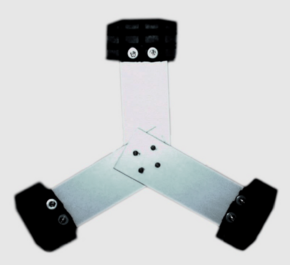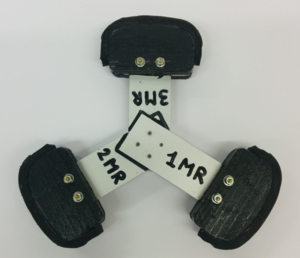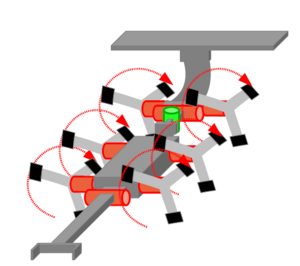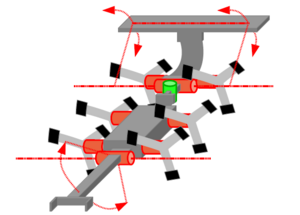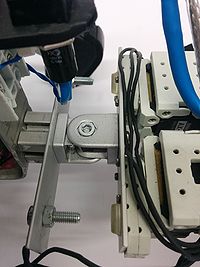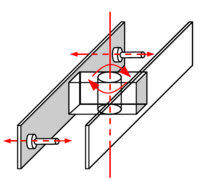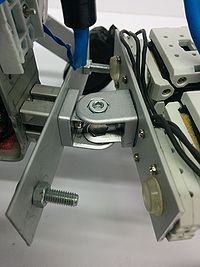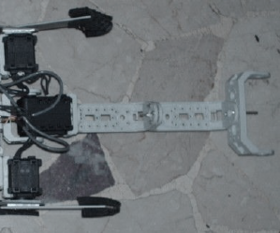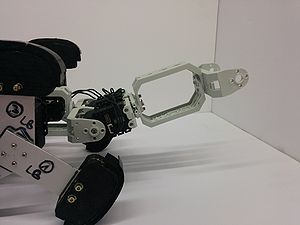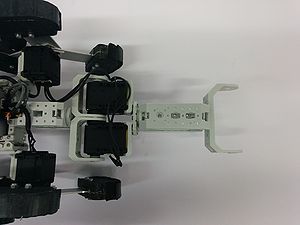Difference between revisions of "LionHell McMillan II"
| Line 26: | Line 26: | ||
<h2> <span class="mw-headline" id="CM_LionHell_II">Control and Mobility in LionHell II</span></h2> | <h2> <span class="mw-headline" id="CM_LionHell_II">Control and Mobility in LionHell II</span></h2> | ||
<h3> <span class="mw-headline" id="Wheg_Lionhell_II">Wheg in LionHell II</span></h3> | <h3> <span class="mw-headline" id="Wheg_Lionhell_II">Wheg in LionHell II</span></h3> | ||
| + | |||
| + | [[File:Wheg LionHell.png|290px|right|Wheg of LionHell]] | ||
| + | [[File:Wheg LionHell II.png|300px|right|Wheg of LionHell II]] | ||
| + | |||
The whegs are a mechanism of locomotion for robots that combine | The whegs are a mechanism of locomotion for robots that combine | ||
simplicity of movement of a wheel with the ability to scale and to overcome obstacles arising from the use of the legs. The acronym derives | simplicity of movement of a wheel with the ability to scale and to overcome obstacles arising from the use of the legs. The acronym derives | ||
| Line 44: | Line 48: | ||
LionHell would irreparably damaged the Wheg and in particular the delicate foothold. | LionHell would irreparably damaged the Wheg and in particular the delicate foothold. | ||
| − | [[File: | + | |
| + | |||
| + | <h3> <span class="mw-headline" id="Central_Passive_Joint">Central Passive Joint</span></h3> | ||
| + | This part will describe the role of the new central passive joint and the increase of the degrees of freedom that resulted. | ||
| + | |||
| + | <h4> <span class="mw-headline" id="DOF_LionHell_II">Degrees of Freedom of LionHell II</span></h4> | ||
| + | The number of degrees of freedom (DoF) of a material point is the number of independent variables needed to determine | ||
| + | uniquely its position in space (coordinates). | ||
| + | The degrees of freedom is a term used to define freedom of movement of a robot in the three spatial skills, and the | ||
| + | number of degrees of freedom of defining a robot configuration. | ||
| + | LionHell II is a hexapod robot equipped with Wheg, tail, a coupling motor that allows him to lift the front in order to better deal with | ||
| + | obstacles, and finally a central passive joint. In the figures you can | ||
| + | observe the degrees of freedom of LionHell II: | ||
| + | <ul> | ||
| + | <li> the movement of Wheg: each wheg has 1 degree of freedom, for a total of 6 degrees of freedom; </li> | ||
| + | <li> the movement of the joint motor and tail, each of which adds 1 degree of freedom, for a total of 2 degrees of freedom; </li> | ||
| + | <li> the central passive joint which was added later, and the green lines trace a possible movement of the front part of the robot. </li> | ||
| + | </ul> | ||
| + | The creation of a robot with a central joint in more passive arose from the idea to facilitate the movements when cornering and allow a more fluid | ||
| + | movement. In the next subsection we will explain in more detail the joint that has been added. | ||
| + | |||
| + | [[File:Dof wheg LionHell.PNG|300px|DoF of the whegs of LionHell II]][[File:Dof giunto LionHell.PNG|300px|DoF of the central passive joint of LionHell II]][[File:Dof testa coda LionHell.PNG|300px|DoF of the frontal part and of the tail of LionHell II]] | ||
| + | |||
| + | |||
| + | <h4> <span class="mw-headline" id="CPJ_LionHell_II">Central Passive Joint of LionHell II</span></h4> | ||
| + | LionHell II is equipped with a passive joint central, whose role is to accompany the movement of Wheg facilitating the movement when the | ||
| + | robot is going to bend. The passive coupling is constituted by: | ||
| + | <ul> | ||
| + | <li> a connecting member which allows rotation of a part of the body of LionHell II; </li> | ||
| + | <li> a pair of metal bars at the two ends of the connecting element, which are part of the security system; </li> | ||
| + | <li> two screws at the ends of the bars, their role is to define the angle of maximum rotation of the joint. </li> | ||
| + | </ul> | ||
| + | The screws may be replaced with shorter or longer, at difference if you want a rotation angle lower or higher. In | ||
| + | current state, the joint is able to rotate 10° to the right or to the left, while with the total absence of the screws the angle increases up to 30°. The addition | ||
| + | screw was necessary as it was presented the risk that the front whegs were to collide with intermediate whegs, risking to block the robot in tight corners. | ||
| + | The addition of the coupling passive was necessary because of the length of LionHell and the difficulty that this had in making some curves | ||
| + | narrow, and the basic idea was to simulate, in some respects, the hook present in the trailers and in trains, with the difference that in this case also | ||
| + | the trailer is able to bend, thus facilitating the movement. | ||
| + | |||
| + | [[File:Central passive joint high.jpg|200px|Central passive joint of LionHell II]][[File:Central passive joint scheme.PNG|200px|Scheme of the central passive joint of LionHell II]][[File:Central passive joint left.jpg|200px|Central passive joint of LionHell II]] | ||
| + | |||
| + | <h3> <span class="mw-headline" id="Tail">Tail</span></h3> | ||
| + | |||
| + | LionHell II is a mobile robot that has to face obstacles of small and medium size, and sometimes finds himself forced to having to overcome obstacles | ||
| + | large. In order for this operation to be successful, it is necessary that the robot does not fall backwards because of repeated setbacks caused from | ||
| + | the movement of the whegs seeking a foothold on which to do strength and lift the rest of the body of the robot. | ||
| + | |||
| + | [[File:Tail side LionHell.png|300px|Previous tail of LionHell]][[File:Tail high LionHell.png|280px|Previous tail of LionHell]] | ||
| + | |||
| + | The addition of the tail ensures greater stability during the climbs and allows him to lift the body preventing the possibility of falling back. | ||
| + | The morphological characteristics that allow the robot to move with greater ease, also facing major obstacles, are: | ||
| + | <ul> | ||
| + | <li> two motors in position mode, which allow the tail to bend and to force the tip when its intervention is required; </li> | ||
| + | <li> the total length of the queue, proportional to the length of the body; </li> | ||
| + | <li> the response of the tail which operates only when the robot is preparing to face major obstacles, recognizable by sensors head. </li> | ||
| + | </ul> | ||
| + | |||
| + | [[File:Tail side LionHell II.jpg |300px|Tail of LionHell II]][[File:Tail high LionHell II.jpg|300px|Tail of LionHell II]] | ||
| + | |||
| + | Compared to the original design, the tail has been modified to intensify the robot and increase the effectiveness and the force with which the tail presses on | ||
| + | terrain, namely: | ||
| + | <ul> | ||
| + | <li> the structure of the queue has been reinforced, in order to avoid that the new tail is damaged over time because of the force developed by engines | ||
| + | and the same weight of the robot; </li> | ||
| + | <li> the strength of the joint that allows the new queue was moving increased, using two motors in parallel that allow LionHell II to move with greater | ||
| + | ease while facing large obstacles. </li> | ||
| + | </ul> | ||
| + | |||
| + | <h2> <span class="mw-headline" id="CM_LionHell_II">Control and Mobility in LionHell II</span></h2> | ||
Revision as of 17:56, 7 April 2015
| Title: | LIONHELL MCMILLAN II: RIPROGETTAZIONE DI UN ROBOT ESAPODE BIOLOGICAMENTE ISPIRATO PER AREE MORFOLOGICAMENTE INSTABILI | [[Image:|center|300px]] |
|---|---|---|
| Description: | Hexapode wheg robot | |
| Tutor: | Giuseppina Gini | |
| Start: | 01/09/2014 | |
| Number of students: | 1 | |
| CFU: | 20 |
CHANGES IN PROGRESS
LionHell McMillan II is an hexapode wheg robot. LionHell McMillan has been developed in a Master Thesis work in Robotics and Artificial Intelligence by Vittorio Lumare ( http://airlab.ws.dei.polimi.it/index.php/LionHell_McMillan )
and it has been modified and improved in a Master Thesis work in Robotics and Artificial Intelligence by Alessandro Rosina (changing the name from "LionHell McMillan" to "LionHell McMillan II").
Info about Thesis
TItle : LIONHELL MCMILLAN II: RIPROGETTAZIONE DI UN ROBOT ESAPODE BIOLOGICAMENTE ISPIRATO PER AREE MORFOLOGICAMENTE INSTABILI Robot Name: LionHell McMillan II Supervisor: Giuseppina Gini Correlator: Vittorio Lumare Author: Alessandro Rosina Area: Robotics and Artifical Intelligence Start date: 2014/09/10 End date: 2015/04/29
Contents
Control and Mobility in LionHell II
Wheg in LionHell II
The whegs are a mechanism of locomotion for robots that combine
simplicity of movement of a wheel with the ability to scale and to overcome obstacles arising from the use of the legs. The acronym derives
by the combination of words wheel and leg, and mechanically consist of a central rotary axis which are connected one or more bars
which perform the function of the legs.
LionHell II has a total of 6 Wheg and each Wheg is composed of 3 bars arranged at 120° apart from each from the other, the ends of which is
mounted a foot slightly curved so as to ensure a secure grip on the ground. The movement of Wheg is simultaneous and each Wheg is controlled
by an independent motor that works in continuous mode, ensuring a smooth motion and robot suitable for every situation.
The Wheg that owns LionHell II is characterized by:
- a structure baseline, aluminium, guarantees the point of contact with the central hub;
- a basal structure of the foot, wood, molded according to an embodiment curve so as to adapt better to the ground and avoid jolts;
- the foam, in contact with the foot structure, reduces shocks of the robot in contact with the ground;
- rubber, in direct contact with the ground, protects the foam wear and allows the robot to move easily on any surface area;
- the symbol allows to easily identify the components of the Wheg and position of the leg in the same robot;
- the outline contour allows to understand intuitively the position with which the other members of Wheg be mounted.
- the movement of Wheg: each wheg has 1 degree of freedom, for a total of 6 degrees of freedom;
- the movement of the joint motor and tail, each of which adds 1 degree of freedom, for a total of 2 degrees of freedom;
- the central passive joint which was added later, and the green lines trace a possible movement of the front part of the robot.
- a connecting member which allows rotation of a part of the body of LionHell II;
- a pair of metal bars at the two ends of the connecting element, which are part of the security system;
- two screws at the ends of the bars, their role is to define the angle of maximum rotation of the joint.
- two motors in position mode, which allow the tail to bend and to force the tip when its intervention is required;
- the total length of the queue, proportional to the length of the body;
- the response of the tail which operates only when the robot is preparing to face major obstacles, recognizable by sensors head.
- the structure of the queue has been reinforced, in order to avoid that the new tail is damaged over time because of the force developed by engines and the same weight of the robot;
- the strength of the joint that allows the new queue was moving increased, using two motors in parallel that allow LionHell II to move with greater ease while facing large obstacles.
Compared to the previous model, we have kept the metal rod base and the rubber that was removed from the foot, since the movement of the same LionHell would irreparably damaged the Wheg and in particular the delicate foothold.
Central Passive Joint
This part will describe the role of the new central passive joint and the increase of the degrees of freedom that resulted.
Degrees of Freedom of LionHell II
The number of degrees of freedom (DoF) of a material point is the number of independent variables needed to determine uniquely its position in space (coordinates). The degrees of freedom is a term used to define freedom of movement of a robot in the three spatial skills, and the number of degrees of freedom of defining a robot configuration. LionHell II is a hexapod robot equipped with Wheg, tail, a coupling motor that allows him to lift the front in order to better deal with obstacles, and finally a central passive joint. In the figures you can observe the degrees of freedom of LionHell II:
The creation of a robot with a central joint in more passive arose from the idea to facilitate the movements when cornering and allow a more fluid movement. In the next subsection we will explain in more detail the joint that has been added.
Central Passive Joint of LionHell II
LionHell II is equipped with a passive joint central, whose role is to accompany the movement of Wheg facilitating the movement when the robot is going to bend. The passive coupling is constituted by:
The screws may be replaced with shorter or longer, at difference if you want a rotation angle lower or higher. In current state, the joint is able to rotate 10° to the right or to the left, while with the total absence of the screws the angle increases up to 30°. The addition screw was necessary as it was presented the risk that the front whegs were to collide with intermediate whegs, risking to block the robot in tight corners. The addition of the coupling passive was necessary because of the length of LionHell and the difficulty that this had in making some curves narrow, and the basic idea was to simulate, in some respects, the hook present in the trailers and in trains, with the difference that in this case also the trailer is able to bend, thus facilitating the movement.
Tail
LionHell II is a mobile robot that has to face obstacles of small and medium size, and sometimes finds himself forced to having to overcome obstacles large. In order for this operation to be successful, it is necessary that the robot does not fall backwards because of repeated setbacks caused from the movement of the whegs seeking a foothold on which to do strength and lift the rest of the body of the robot.
The addition of the tail ensures greater stability during the climbs and allows him to lift the body preventing the possibility of falling back. The morphological characteristics that allow the robot to move with greater ease, also facing major obstacles, are:
Compared to the original design, the tail has been modified to intensify the robot and increase the effectiveness and the force with which the tail presses on terrain, namely:

